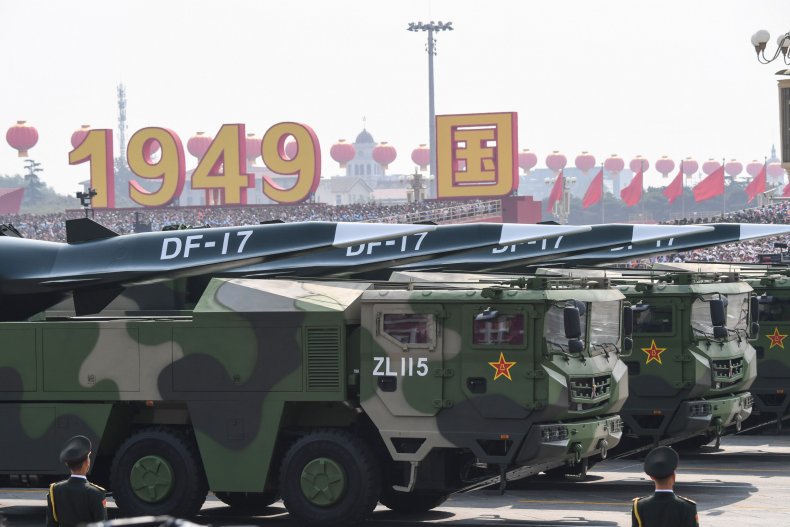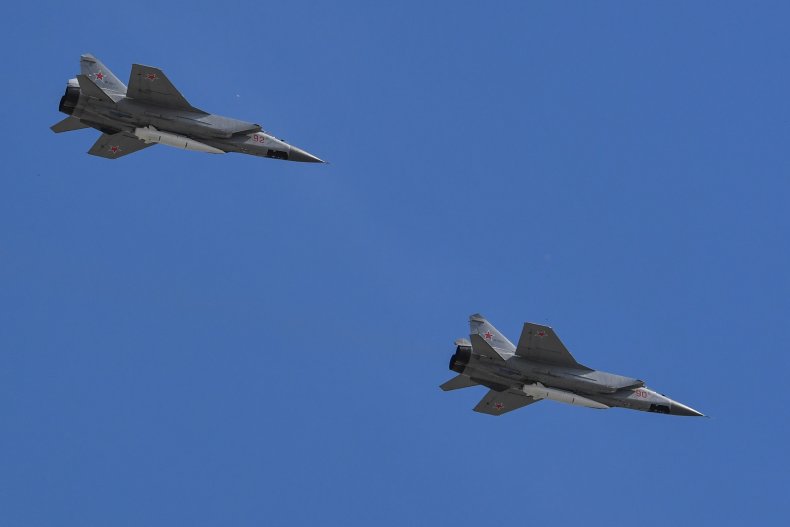China’s Shock Hypersonic Missile Test Alarms U.S. Lawmakers: ‘National Security Crisis’
China’s most recent successful test of a nuclear-capable hypersonic missile has shaken American military officials and politicians, putting a fresh focus on America’s own hypersonic programs which appear—at least publicly—to lag those in Russia and China.
In the August test, a Chinese rocket carrying a hypersonic glide vehicle circled the Earth at low altitude before descending to its target, missing by about 19 miles, according to the Financial Times.
Chairman of the Joint Chiefs of Staff General Mark Milley said the test was “very close” to a modern “Sputnik moment”—a reference to the 1957 Soviet satellite launch that birthed the Cold War space race.
Several lawmakers on the Senate and House armed services committees told Newsweek that the U.S. must take the Chinese hypersonic threat seriously, and urged the Pentagon to re-evaluate its own priorities.
“This test must be a wake-up call for the U.S.,” Sen. Jim Inhofe (R-OK) told Newsweek.
The ranking member of the Senate Armed Services Committee added: “China is modernizing and growing its military—this is an indisputable fact. If we fail to meet this challenge, we will fail to deter the very real threat it poses.”
Sen. Angus King (I-ME), also a member of the Armed Services Committee, told Newsweek: “The U.S. cannot lag in this development or allow for blind spots as we monitor the progress of our competitors.”
The Indo-Pacific is central to America’s foreign policy future. Washington, D.C. is slowly disengaging from decades of politically disastrous and regionally devastating conflict in the Middle East and focusing instead on likely flashpoints with an ever-stronger China.
Taiwan, the South China Sea, key shipping lines in Southeast Asia and the Indian Ocean; these would be the battlefields of a hot U.S.-China conflict.
The regional situation is already tense. American and Chinese forces regularly confront each other in the disputed South China Sea. Saber rattling over Taiwan—which China considers a renegade Chinese province rather than an independent state—threatens to spill over into war.
“U.S. military supremacy is absolutely being eroded, and the balance of power in the Indo-Pacific is shifting—not in our favor,” Inhofe said.
Rep. Joe Wilson (R-SC), a member of the House Armed Services Committee, said: “China’s recent hypersonic test is alarming because of their aggressive behavior in the Indo-Pacific region.”
Committee colleague Rep. Jim Banks (R-IN) said the recent hypersonic test “is extremely concerning” given the shifting military balance between the world’s two best-funded militaries.
“Even before the test, multiple Pentagon wargames concluded we’d lose to China in an all-out conflict. And China is getting closer to conventional attack capability against the U.S. mainland…The China threat is now a national security crisis.”
Nuclear ‘Game Changer’
The nascent hypersonic arms race is no secret. The world’s top military powers have been working for years to fine-tune the futuristic weapons.
Hypersonic missiles fly faster—at Mach 5, five times the speed of sound—and at a lower trajectory than ballistic missiles, and can maneuver in flight. This all makes it more difficult for existing defense networks to intercept them.
Russian President Vladimir Putin famously boasted in 2018 that one of his new hypersonic missiles would be “practically invulnerable” to American and NATO interceptors.
Russia and China have already deployed hypersonic weapons, while the U.S. has not. China deployed its first hypersonic missile—the nuclear-capable medium-range DF-17 glide vehicle—in 2019. Russia also deployed its first nuclear-capable Avangard hypersonic glide vehicle in 2019.
The U.S. has two ongoing hypersonic projects, one run by the Army and the other by the Navy. Last year, a joint Army-Navy test saw a hypersonic missile land within six inches of its target, according to the Pentagon.
Deployed Russian and Chinese weapons—plus China’s round-the-world latest test—mean tough questions for the U.S. military-industrial establishment.
Pentagon Press Secretary John Kirby said in October that U.S. hypersonic weapon progress “is real, it’s tangible, and we are absolutely working toward being able to develop that capability.” He declined to share specifics with reporters.
With a budget more than that of Russia and China combined—though observers suggest that Moscow and Beijing conceal some defense spending—some are asking why the Pentagon is lagging on hypersonics.
“Hypersonic weapons is certainly an area where we need to accelerate and intensify our efforts,” Inhofe told Newsweek.
Former President Donald Trump‘s final defense budget for the fiscal year 2021 requested $3.2 billion for all hypersonics-related research. President Joe Biden‘s 2022 fiscal year budget is requesting $3.8 billion; an almost 20 percent increase.
Lawmakers will still push for more. King told Newsweek: “I will continue pressing administration and military officials to give this matter the attention and resources required to defend our nation.”
Progressives have long railed against the “bloated” Pentagon budget, swollen by decades of sprawling, primarily counter-insurgency foreign interventions. The Pentagon is now pivoting to a new era of “strategic competition”—i.e. great power competition with China, and less so Russia—and must assess its priorities and processes.
“The Pentagon’s resource allocation and planning are hampered by bureaucracy and politics,” Banks said. “There’s a lot we can change.”
The hypersonic debate will certainly undermine progressive efforts to trim the military budget. “We can only achieve peace through strength, and it is inconceivable that we would under-invest in our military at a time when Russia and China are testing our resolve,” Wilson said.
A Republican national security staffer who did not wish to be named told Newsweek that Pentagon leaders “have got to get themselves into a headspace where they can shed everything that’s superfluous and unnecessary.”
“Every spending line item like that doesn’t directly contribute to the realities of 21st-century warfare, they have to get rid of whatever that thing is,” the staffer said.
“The department writ large is in widespread need of reform that focuses it intellectually, physically, technologically, etc., on the fight ahead.”
Spending alone won’t solve the problem. “It’s got to be smart spending,” the staffer said. “And there has to be cultural reforms in the Defence Department that match any increases in the defense budget.”

GREG BAKER/AFP via Getty Images
Arms Control Standoff
China is not constrained by any strategic arms control agreements. The U.S. and Russia signed several such agreements during the Cold War, though several have since collapsed or lapsed.
Earlier this year, and days before its expiry, Biden approved a five-year extension of the 2010 New START treaty which capped U.S. and Russian strategic nuclear arsenals at 1,550 deployed warheads and 700 deployed missiles and heavy bombers each.
But Biden’s administration, like Trump’s before it, has stressed that China must be brought into the strategic arms control fold. Beijing has so far refused.
Last year, Fu Cong, the head of the Chinese Foreign Ministry’s arms control department told a press conference in Beijing: “I can assure you that if the U.S. says that they are ready to come down to the Chinese level [of nuclear weapons], China will be happy to participate the next day. But actually, we know that’s not going to happen.”
House Armed Services Committee Ranking Member Rep. Mike Rogers (R-AL) told Newsweek it “seems clear” that Chinese obstinacy on arms control violates its United Nations Non-Proliferation of Nuclear Weapons treaty commitments.
Article VI of that treaty commits signatories “to pursue negotiations in good faith on effective measures relating to cessation of the nuclear arms race at an early date and to nuclear disarmament.”
Arms control would have broad bipartisan support but must include Beijing. The GOP national security staffer said: “You’re just not going to get an arms control treaty passed in the Senate in 2026 that doesn’t constrain the Chinese as well. Without looping in the Chinese, there’s no point. We don’t live in the Cold War anymore. Bilateral arms control treaties are dead.”
The details of any future agreements could divide Congress—particularly if the U.S. agreed to reduce its own arsenal or stunt its own research.
Inhofe told Newsweek: “I would welcome conversations to reduce tensions, but such conversations should not be based solely on U.S. concessions.
“We need to see serious changes to Putin’s and Xi’s provocative behavior, and I’m skeptical that would happen any time soon.
“Our nuclear forces are our greatest deterrent. We have seen time and time again that it’s naïve to believe that if we simply abandon our deterrent, others will follow.
“Concessions in this regard would have little to no impact in limiting China and Russia’s military ambitions or policies, but would significantly undermine our allies’ confidence in the United States and our security guarantees, and make us less safe.”
Banks, too, cautioned against any U.S. concessions. “The Biden administration must strengthen our capacity to counter Chinese aggression and establish credible U.S. deterrence—not just by expanding hypersonic missile research, but also by working more closely with our allies,” he said.
The Biden administration is currently preparing its nuclear posture review. The document will be telling in how the White House intends to approach arms control vis-à-vis Beijing.
“I strongly caution the Biden administration against negotiating away American peace through strength in their upcoming nuclear posture review and oppose any hypersonics arms agreements until China becomes a more constructive international partner,” Wilson said.
America’s defense strategy, too, has to tread a fine line. The network must be capable of defeating strikes from smaller adversaries like Iran and North Korea, but not so capable to spark an arms race with Russia and China.
If America is too secure, it could upset the Mutually Assured Destruction (MAD) concept that has arguably prevented devastating nuclear conflict.
Former President Ronald Reagan’s controversial and ultimately abandoned Strategic Defense Initiative—nicknamed “Star Wars”—is one example of how improved defense can destabilize MAD.
Rogers told Newsweek that Chinese and Russian advances cannot be justified by America’s current network of ground-based interceptors.
“The notion that the 44 Ground Based Interceptors that the U.S. fields to protect the homeland for North Korea forced Russia and China’s hand in this regard is hot-garbage,” Rogers said.
Newsweek has contacted the White House for comment on the U.S.-China nuclear balance and any plans for future arms control outreach.
Hypersonics: The New Normal?
Smaller nations are closely watching the “big three” as they push ahead. Nations including India, the U.K., Israel, South Korea, Australia, and Japan are already working on their own hypersonic applications.
American adversaries like Iran and North Korea will no doubt have similar plans. Lawmakers warned that China and Russia may yet seek to support such hypersonic programs, as they have done ballistic missile and other weapons research in the past.
“It would not surprise me if Pyongyang and Tehran obtain hypersonic technologies through similar illicit networks in the future,” Inhofe told Newsweek.
Banks described proliferation as “a serious concern.” He said: “China has a well-documented track record of transferring advanced military technology, including nuclear and missile technologies to rogue regimes, such as North Korea and Iran.”
Rogers, too, said the “non-proliferation track records of Russia and China are abysmal, so sure, that’s a risk. It doesn’t have to only be whole systems either. There’s technology transfer and parts-and-components to worry about as well.”
Ultimately there is little Washington, D.C. can do to stop it. “All countries will eventually catch up; that’s just the evolving nature of not just war technology, but technology writ large,” the GOP staffer said.
The question then is staying ahead of the game. “They evolve, we evolve,” the staffer said.

YURI KADOBNOV/AFP via Getty Images


